Macrophages
Introduction, structure, formation function, subtypes and role in pathological process
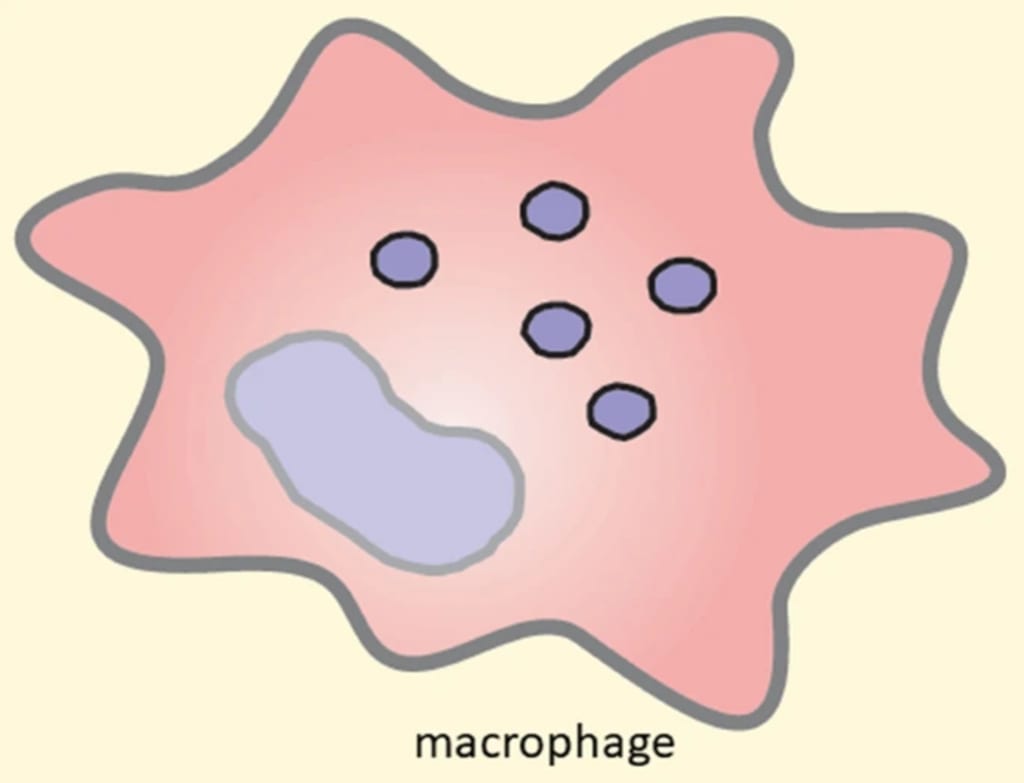
Macrophages
Introduction:
Macrophages are a particular class of immune cell that are crucial to the innate immune response. Macrophages located all over the body so they have a number of roles including phagocytosis (the capture of invading microorganisms), antigen presentation, cytokine release, tissue healing, and remodelling. Macrophages can differentiate into many subtypes based on their environment and external stimuli. They are a component of the innate immune system, which serves as the body's first line of defence against pathogen invasion. Macrophages are derived from circulating monocytes, which migrate to tissues where they differentiate into macrophages. The term macrophage is formed by the combination of the Greek terms "makro" meaning big and "phagein" meaning eat.
Macrophages structure:
The plasma membrane, the cytoplasm, cytoskeleton and the nucleus make up the main parts of a macrophage's structure.
• Plasma membrane: The lipid bilayer that forms the macrophage plasma membrane divides the cell's interior and exterior surroundings. The macrophage is equipped with a variety of receptors, channels, and transporters that enable it to interact with its environment and ingest foreign particles. Pseudopodia, which are dynamic extensions of the plasma membrane and are specialized structures with the ability to surround, are also present in the plasma membrane.
• Nucleus: The macrophage nucleus is a large, oval-shaped structure that stores the genetic material of the cell. The nuclear envelope, a double membrane that encloses the nucleus and has nuclear pores for molecule entry and escape, surrounds it. Through controlling gene expression, the nucleus directs the actions of the cell. It also aids in cell division.
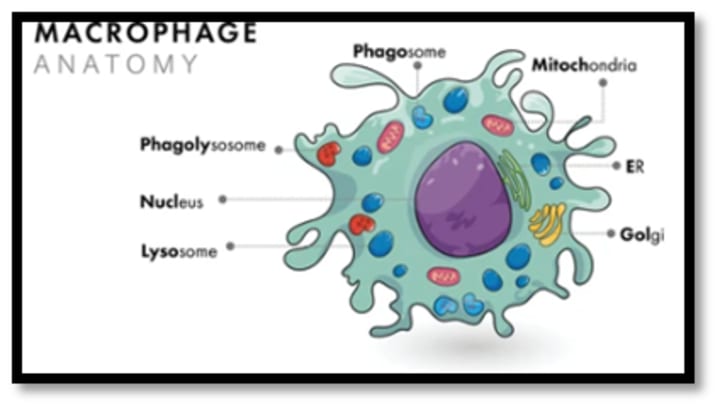
Formation of macrophages:
Monocytes, one of the main subgroups of immune system's white blood cells, differentiate into macrophages. The monocytes leave the bloodstream, penetrate the infected tissue or organ, and go through a sequence of modifications to become macrophages when there is tissue damage or infection.
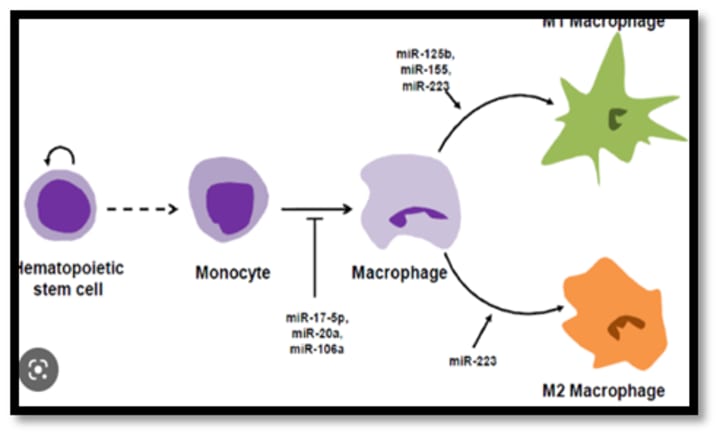
Functions of macrophages in the immune response:
• Phagocytosis, the process by which invading microbes including bacteria, viruses, and fungi are engulfed and eliminated by macrophages, is one of their primary responsibilities. Macrophages use receptors on their surface, such as toll-like receptors (TLRs) and scavenger receptors, to recognise and bind to these pathogens. Lysosomal enzymes and reactive oxygen species are used by the macrophage to kill the pathogen after it has been ingested.
• The antigen presentation to T cells is another function of macrophages. They have the capacity to display antigenic peptides to T cells on their surface in the presence of MHC molecules. As a result, an adaptive immune response is sparked against the invasive infection, activating T cells.
Differentiation and Activation of Macrophages:
Circulating monocytes, which are generated in the bone marrow, are the precursor of macrophages. When released into the bloodstream, monocytes have the ability to move to tissues where they can develop into macrophages. When entering the tissue, cytokines like granulocyte-macrophage colony-stimulating factor (GM-CSF) and macrophage colony-stimulating factor (M-CSF) cause monocytes to develop into macrophages (GM-CSF).
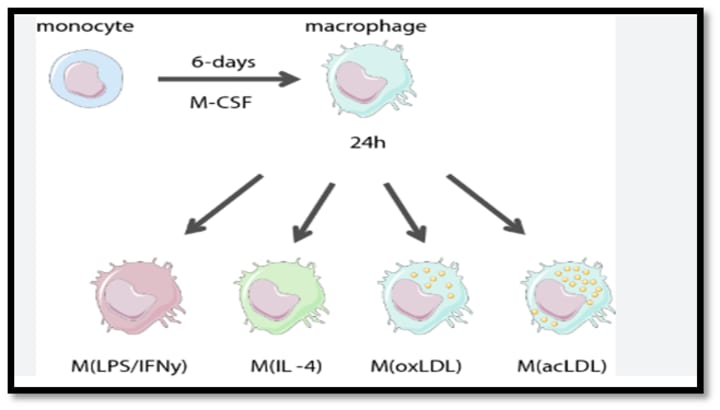
Macrophages subtypes:
o Interferon-gamma (IFN-gamma) and lipopolysaccharide (LPS), which are produced by T cells and bacteria, respectively, activate M1 macrophages, which are pro-inflammatory cells. Tumor necrosis factor (TNF-alpha) and IL-1, two cytokines that are highly produced by M1 macrophages and are also involved in phagocytosis and antigen presentation, can promote inflammation and draw neutrophils to the site of infection.
o The anti-inflammatory cytokines interleukin-4 (IL-4) and interleukin-13 (IL-13), which are made by T cells and other immune cells, stimulate M2 macrophages. M2 macrophages generate cytokines like interleukin-10 (IL-10) and transforming growth factor-beta, which are used in tissue remodelling and repair (TGF-beta).
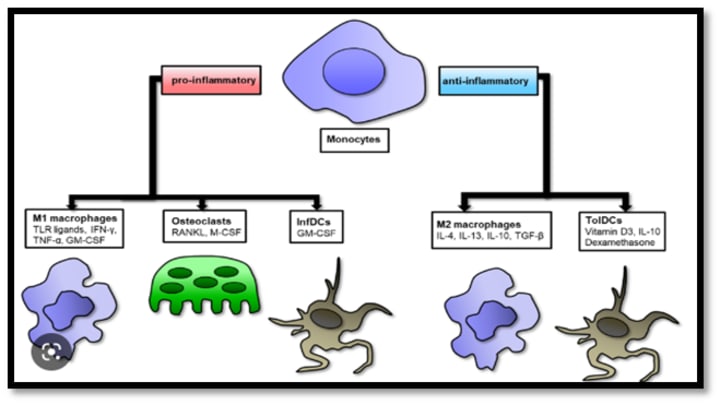
Function and location of macrophages:
The location and function of a few different macrophage populations are described here:
• Alveolar macrophage: Phagocytosis of minute particles, dead cells, or bacteria in lung alveoli. development and management of respiratory pathogen immunity. a primary line of protection against invasive respiratory infections. They share space with pneumocytes in the inter-alveolar septum and pulmonary alveoli.
• Splenic macrophages: (metallophilic, red pulp, and marginal zone macrophages): Red and white pulp in the spleen marginal zone – removal of damaged or ageing red blood cells.
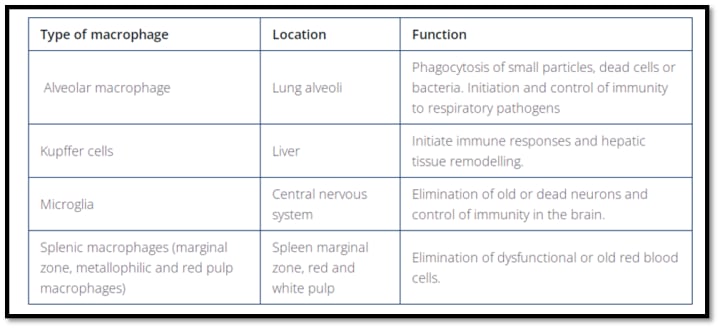
• Nearly every tissue is invaded by macrophages, which move about and search for pathogens or dead cells. The distribution and purpose of a few different macrophage populations are shown in the table below.
Role in pathological process:
It is widely acknowledged that macrophages are important in a variety of chronic inflammatory disorders, including atherosclerosis, obesity, diabetes, cancer, skin problems, and even neurological diseases. These are some examples.
o Macrophage activation syndrome is brought on by systemic SARS-CoV-2-related consequences like acute respiratory distress syndrome (ARDS), disseminated intravascular coagulation syndrome, edoema, and pneumonia, which are all signs of significant macrophage activation.
o Atherosclerosis: It is a chronic condition that begins with monocyte penetration into the subendothelium and development into macrophages. The majority of the immune cells in atherosclerotic plaques are macrophages, which play a role in the plaques' dynamic evolution. In all stages of atherosclerosis, resident macrophage
About the Creator
Enjoyed the story? Support the Creator.
Subscribe for free to receive all their stories in your feed. You could also pledge your support or give them a one-off tip, letting them know you appreciate their work.

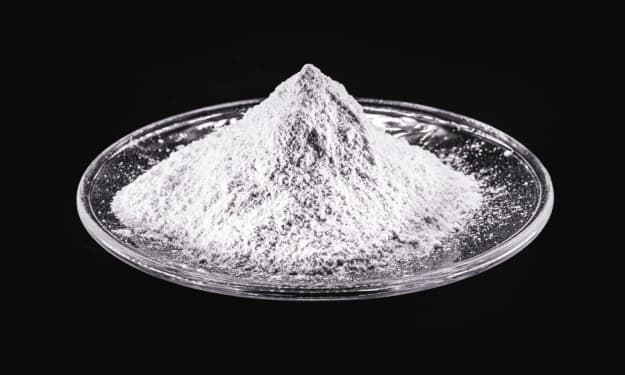



Comments
There are no comments for this story
Be the first to respond and start the conversation.